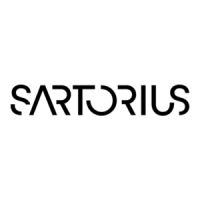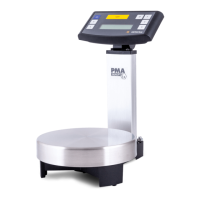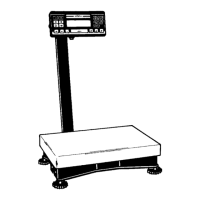Do you have a question about the Sartorius Quintix and is the answer not in the manual?
Identifies hazard symbols for death, injury, or material damage.
Explains symbols for tips, legal metrology, operation notes, and manual conventions.
Contact information for application advice and technical support.
Essential guidelines for safe operation, compliance, and handling of the balance.
Safety instructions for installing the balance, AC adapter, and avoiding hazards.
Specifies the balance's intended use in laboratories and appropriate environmental conditions.
Detailed view of the balance, its parts, and their functions with diagrams.
Instructions for unpacking, checking equipment, and listing included parts.
Step-by-step guide for installing the balance, including draft shield and weighing components.
Guidance on selecting the best setup location, considering environmental factors.
Instructions for safely moving the balance, including re-leveling and calibration advice.
Details on assembling and connecting the AC adapter and power plug.
Specifies the required warm-up time for the balance to ensure accuracy.
Instructions for switching on the balance and configuring initial settings via the startup wizard.
How to use the below-balance weighing port and attach samples securely.
Guidance on installing an anti-theft locking cable or chain to secure the balance.
Instructions for switching the balance on, off, and managing standby mode.
Explains the importance and methods of leveling for precise weighing results.
Overview of the balance's operating concept, display elements, menu, and applications.
Guide on navigating the setup menu and modifying balance configuration.
Comprehensive overview of all configurable settings, including language, date, time, and USB.
Configure weight units, accuracy, and view conversion factors.
Ensures weighing results meet minimum sample quantity standards for USP compliance.
Defines identifiers for print jobs like device, batch, and sample IDs.
Weighs multiple components for mixtures or formulas in one container.
Saves and statistically evaluates weight values, providing results like average and deviation.
Saves and sums weight values from components weighed in different containers.
Determines the density of solids using the buoyancy method and Archimedes' principle.
Calculates the percentage share or difference of a sample relative to a reference weight.
Multiplies weight values by a user-defined factor for custom calculations.
Weighs moving samples or in unstable environments with averaging of measurements.
Checks if weight is within tolerances or aids in filling to a specific target weight.
Calculates and displays the maximum weight value (peak value) of a sample.
Determines the number of parts by calculating reference sample weight and weighing unknown counts.
Details on internal, external, and automatic (isoCAL) calibration procedures.
Details the data included in GLP headers and footers for printouts.
System settings required to activate and format ISO/GLP compliant printouts.
Steps to print headers, measurement values, and footers for ISO/GLP compliance.
How the balance interfaces with printers and PCs via USB and serial ports.
Connecting the balance to a PC for data transfer using various formats and drivers.
Defines data output parameters, formats, input commands, and interface specifications.
Explains how available keys are dynamically shown to prevent operating errors.
Lists and explains various error messages encountered during operation and calibration.
Instructions for safely preparing the balance for transport, including part removal.
Recommendations for regular service, professional repairs, and general cleaning.
Detailed instructions for cleaning the balance housing, draft shield, and its components.
Instructions for disposing of packaging and the device according to local regulations.
Technical specifications for AC adapter, balance, ambient conditions, safety, and EMC.
Detailed technical specifications for various Secura®, Quintix®, and Practum® models.
Specifications for verified models with country-specific type approval certificates.
List of optional accessories for the balances, including printers, cables, and weights.
Diagrams showing the physical dimensions of different balance models.
Formal declaration of compliance with relevant EU directives for the equipment.
Official certificates confirming type approval and compliance with standards.
Explanation of the various plates and markings found on the balance.
Identifies hazard symbols for death, injury, or material damage.
Explains symbols for tips, legal metrology, operation notes, and manual conventions.
Contact information for application advice and technical support.
Essential guidelines for safe operation, compliance, and handling of the balance.
Safety instructions for installing the balance, AC adapter, and avoiding hazards.
Specifies the balance's intended use in laboratories and appropriate environmental conditions.
Detailed view of the balance, its parts, and their functions with diagrams.
Instructions for unpacking, checking equipment, and listing included parts.
Step-by-step guide for installing the balance, including draft shield and weighing components.
Guidance on selecting the best setup location, considering environmental factors.
Instructions for safely moving the balance, including re-leveling and calibration advice.
Details on assembling and connecting the AC adapter and power plug.
Specifies the required warm-up time for the balance to ensure accuracy.
Instructions for switching on the balance and configuring initial settings via the startup wizard.
How to use the below-balance weighing port and attach samples securely.
Guidance on installing an anti-theft locking cable or chain to secure the balance.
Instructions for switching the balance on, off, and managing standby mode.
Explains the importance and methods of leveling for precise weighing results.
Overview of the balance's operating concept, display elements, menu, and applications.
Guide on navigating the setup menu and modifying balance configuration.
Comprehensive overview of all configurable settings, including language, date, time, and USB.
Configure weight units, accuracy, and view conversion factors.
Ensures weighing results meet minimum sample quantity standards for USP compliance.
Defines identifiers for print jobs like device, batch, and sample IDs.
Weighs multiple components for mixtures or formulas in one container.
Saves and statistically evaluates weight values, providing results like average and deviation.
Saves and sums weight values from components weighed in different containers.
Determines the density of solids using the buoyancy method and Archimedes' principle.
Calculates the percentage share or difference of a sample relative to a reference weight.
Multiplies weight values by a user-defined factor for custom calculations.
Weighs moving samples or in unstable environments with averaging of measurements.
Checks if weight is within tolerances or aids in filling to a specific target weight.
Calculates and displays the maximum weight value (peak value) of a sample.
Determines the number of parts by calculating reference sample weight and weighing unknown counts.
Details on internal, external, and automatic (isoCAL) calibration procedures.
Details the data included in GLP headers and footers for printouts.
System settings required to activate and format ISO/GLP compliant printouts.
Steps to print headers, measurement values, and footers for ISO/GLP compliance.
How the balance interfaces with printers and PCs via USB and serial ports.
Connecting the balance to a PC for data transfer using various formats and drivers.
Defines data output parameters, formats, input commands, and interface specifications.
Explains how available keys are dynamically shown to prevent operating errors.
Lists and explains various error messages encountered during operation and calibration.
Instructions for safely preparing the balance for transport, including part removal.
Recommendations for regular service, professional repairs, and general cleaning.
Detailed instructions for cleaning the balance housing, draft shield, and its components.
Instructions for disposing of packaging and the device according to local regulations.
Technical specifications for AC adapter, balance, ambient conditions, safety, and EMC.
Detailed technical specifications for various Secura®, Quintix®, and Practum® models.
Specifications for verified models with country-specific type approval certificates.
List of optional accessories for the balances, including printers, cables, and weights.
Diagrams showing the physical dimensions of different balance models.
Formal declaration of compliance with relevant EU directives for the equipment.
Official certificates confirming type approval and compliance with standards.
Explanation of the various plates and markings found on the balance.
| Display | Backlit LCD |
|---|---|
| Response Time | 1.5 s |
| Operating Temperature | +10°C to +30°C |
| Readability | 0.1 mg to 1 g |
| Calibration | Internal/External |
| Connectivity | RS-232, USB |
| Repeatability | 0.1 mg |
| Linearity | ±0.2 mg |
| Operating Humidity | 15% to 80% non-condensing |
| Power Supply | 100 – 240 V, 50/60 Hz |
| Pan Size | Varies by model, typically 90 mm diameter (round) or 190 x 204 mm (rectangular) |











